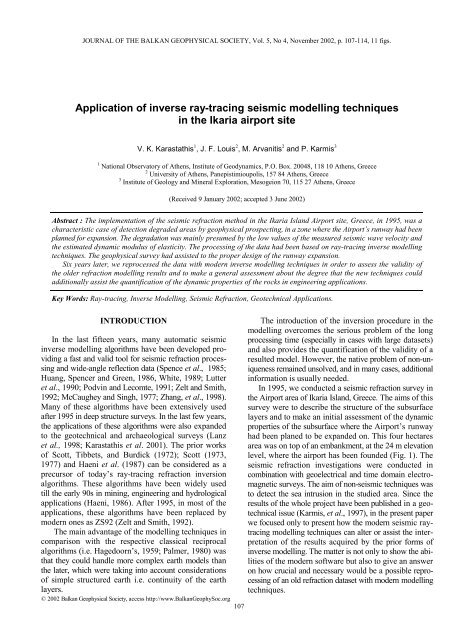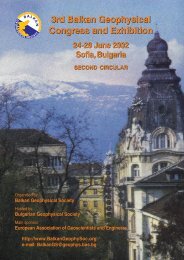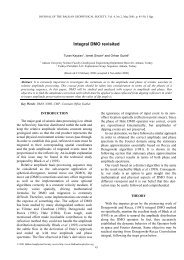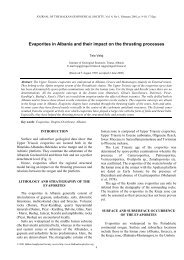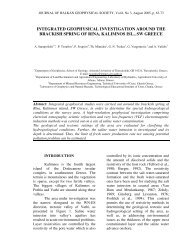Application of inverse ray-tracing seismic modelling techniques
Application of inverse ray-tracing seismic modelling techniques
Application of inverse ray-tracing seismic modelling techniques
You also want an ePaper? Increase the reach of your titles
YUMPU automatically turns print PDFs into web optimized ePapers that Google loves.
JOURNAL OF THE BALKAN GEOPHYSICAL SOCIETY, Vol. 5, No 4, November 2002, p. 107-114, 11 figs.<br />
<strong>Application</strong> <strong>of</strong> <strong>inverse</strong> <strong>ray</strong>-<strong>tracing</strong> <strong>seismic</strong> <strong>modelling</strong> <strong>techniques</strong><br />
in the Ikaria airport site<br />
V. K. Karastathis 1 , J. F. Louis 2 , M. Arvanitis 2 and P. Karmis 3<br />
1 National Observatory <strong>of</strong> Athens, Institute <strong>of</strong> Geodynamics, P.O. Box. 20048, 118 10 Athens, Greece<br />
2 University <strong>of</strong> Athens, Panepistimioupolis, 157 84 Athens, Greece<br />
3 Institute <strong>of</strong> Geology and Mineral Exploration, Mesogeion 70, 115 27 Athens, Greece<br />
(Received 9 January 2002; accepted 3 June 2002)<br />
Abstract : The implementation <strong>of</strong> the <strong>seismic</strong> refraction method in the Ikaria Island Airport site, Greece, in 1995, was a<br />
characteristic case <strong>of</strong> detection degraded areas by geophysical prospecting, in a zone where the Airport’s runway had been<br />
planned for expansion. The degradation was mainly presumed by the low values <strong>of</strong> the measured <strong>seismic</strong> wave velocity and<br />
the estimated dynamic modulus <strong>of</strong> elasticity. The processing <strong>of</strong> the data had been based on <strong>ray</strong>-<strong>tracing</strong> <strong>inverse</strong> <strong>modelling</strong><br />
<strong>techniques</strong>. The geophysical survey had assisted to the proper design <strong>of</strong> the runway expansion.<br />
Six years later, we reprocessed the data with modern <strong>inverse</strong> <strong>modelling</strong> <strong>techniques</strong> in order to assess the validity <strong>of</strong><br />
the older refraction <strong>modelling</strong> results and to make a general assessment about the degree that the new <strong>techniques</strong> could<br />
additionally assist the quantification <strong>of</strong> the dynamic properties <strong>of</strong> the rocks in engineering applications.<br />
Key Words: Ray-<strong>tracing</strong>, Inverse Modelling, Seismic Refraction, Geotechnical <strong>Application</strong>s.<br />
INTRODUCTION<br />
In the last fifteen years, many automatic <strong>seismic</strong><br />
<strong>inverse</strong> <strong>modelling</strong> algorithms have been developed providing<br />
a fast and valid tool for <strong>seismic</strong> refraction processing<br />
and wide-angle reflection data (Spence et al., 1985;<br />
Huang, Spencer and Green, 1986, White, 1989; Lutter<br />
et al., 1990; Podvin and Lecomte, 1991; Zelt and Smith,<br />
1992; McCaughey and Singh, 1977; Zhang, et al., 1998).<br />
Many <strong>of</strong> these algorithms have been extensively used<br />
after 1995 in deep structure surveys. In the last few years,<br />
the applications <strong>of</strong> these algorithms were also expanded<br />
to the geotechnical and archaeological surveys (Lanz<br />
et al., 1998; Karastathis et al. 2001). The prior works<br />
<strong>of</strong> Scott, Tibbets, and Burdick (1972); Scott (1973,<br />
1977) and Haeni et al. (1987) can be considered as a<br />
precursor <strong>of</strong> today’s <strong>ray</strong>-<strong>tracing</strong> refraction inversion<br />
algorithms. These algorithms have been widely used<br />
till the early 90s in mining, engineering and hydrological<br />
applications (Haeni, 1986). After 1995, in most <strong>of</strong> the<br />
applications, these algorithms have been replaced by<br />
modern ones as ZS92 (Zelt and Smith, 1992).<br />
The main advantage <strong>of</strong> the <strong>modelling</strong> <strong>techniques</strong> in<br />
comparison with the respective classical reciprocal<br />
algorithms (i.e. Hagedoorn’s, 1959; Palmer, 1980) was<br />
that they could handle more complex earth models than<br />
the later, which were taking into account considerations<br />
<strong>of</strong> simple structured earth i.e. continuity <strong>of</strong> the earth<br />
layers.<br />
© 2002 Balkan Geophysical Society, access http://www.BalkanGeophySoc.org<br />
107<br />
The introduction <strong>of</strong> the inversion procedure in the<br />
<strong>modelling</strong> overcomes the serious problem <strong>of</strong> the long<br />
processing time (especially in cases with large datasets)<br />
and also provides the quantification <strong>of</strong> the validity <strong>of</strong> a<br />
resulted model. However, the native problem <strong>of</strong> non-uniqueness<br />
remained unsolved, and in many cases, additional<br />
information is usually needed.<br />
In 1995, we conducted a <strong>seismic</strong> refraction survey in<br />
the Airport area <strong>of</strong> Ikaria Island, Greece. The aims <strong>of</strong> this<br />
survey were to describe the structure <strong>of</strong> the subsurface<br />
layers and to make an initial assessment <strong>of</strong> the dynamic<br />
properties <strong>of</strong> the subsurface where the Airport’s runway<br />
had been planed to be expanded on. This four hectares<br />
area was on top <strong>of</strong> an embankment, at the 24 m elevation<br />
level, where the airport has been founded (Fig. 1). The<br />
<strong>seismic</strong> refraction investigations were conducted in<br />
combination with geoelectrical and time domain electromagnetic<br />
surveys. The aim <strong>of</strong> non-<strong>seismic</strong> <strong>techniques</strong> was<br />
to detect the sea intrusion in the studied area. Since the<br />
results <strong>of</strong> the whole project have been published in a geotechnical<br />
issue (Karmis, et al., 1997), in the present paper<br />
we focused only to present how the modern <strong>seismic</strong> <strong>ray</strong><strong>tracing</strong><br />
<strong>modelling</strong> <strong>techniques</strong> can alter or assist the interpretation<br />
<strong>of</strong> the results acquired by the prior forms <strong>of</strong><br />
<strong>inverse</strong> <strong>modelling</strong>. The matter is not only to show the abilities<br />
<strong>of</strong> the modern s<strong>of</strong>tware but also to give an answer<br />
on how crucial and necessary would be a possible reprocessing<br />
<strong>of</strong> an old refraction dataset with modern <strong>modelling</strong><br />
<strong>techniques</strong>.
108 Karastathis et al.<br />
FIG. 1. The runway <strong>of</strong> the Ikaria airport is oriented NNE-SSW and terminated on an embankment area near the coast.<br />
At this area the runway was planned to be extended. (photo: Air Traffic Safety Electronic Engineers Association <strong>of</strong><br />
Hellenic Civil Aviation Authority: http://www.hcaa-eleng.gr/ikaria.htm)<br />
GEOLOGICAL SETTING<br />
The bedrock that underlies the embankment is a metamorphosed<br />
unit constituted by phyllite and schist, with<br />
a succession <strong>of</strong> intercalated carbonate layers. Highly<br />
fractured carbonate layers are observed on the outcrops.<br />
The surface sediments consist <strong>of</strong> sand and pebble conglomerate.<br />
The embankment material is made <strong>of</strong> scree and<br />
boulders.<br />
DATA ACQUISITION AND PROCESSING<br />
A number <strong>of</strong> P-wave <strong>seismic</strong> refraction pr<strong>of</strong>iles were<br />
conducted in the investigated area. Additional P-wave<br />
refraction survey was carried out to estimate the Poisson<br />
ratio <strong>of</strong> the bedrock in an adjacent area where the bedrock<br />
outcropped. Some shorter S-wave refraction<br />
pr<strong>of</strong>iles were also conducted in order to contribute to<br />
the assessment <strong>of</strong> the dynamic properties <strong>of</strong> the layers.<br />
The locations <strong>of</strong> the P-wave refraction pr<strong>of</strong>iles IKRP1,<br />
IKRP2, IKRP3 and IKRP4 are shown in Figure 2. The<br />
dataset IKRP1 was acquired with the use <strong>of</strong> 48 geophones<br />
and spacing interval <strong>of</strong> 4 m. A 24 geophone layout<br />
was used in all the other lines. The receiver interval was<br />
4 m for IKRP2 and IKRP3 and 2 m for IKRP4. The<br />
lengths <strong>of</strong> the IKRP1, IKRP2, IKRP3 and IKRP4 were<br />
188, 92, 92 and 46 m respectively. Dynamite was used<br />
as <strong>seismic</strong> source for the data acquisition and the resonant<br />
frequency <strong>of</strong> geophones was 10 Hz. The data recording<br />
unit was an ABEM Terraloc instrument.<br />
The first processing <strong>of</strong> the data (Karmis et al., 1997)<br />
was done by the use <strong>of</strong> the inversion <strong>ray</strong>-<strong>tracing</strong> <strong>modelling</strong><br />
algorithm SIPT1 <strong>of</strong> Haeni et al. (1987), based on<br />
the previous work <strong>of</strong> Scott, Tibbets and Burdick (1972)<br />
and Scott (1973, 1977). The program could handle mo-<br />
FIG. 2. Sketch map <strong>of</strong> the P-wave refraction pr<strong>of</strong>iles.<br />
dels with steeply dipping layers and abrupt changes in<br />
velocity. Its ability for data processing was limited to 48<br />
traces per shot and seven shots per spread. The algorithm<br />
could support models only with five or less layers. The<br />
inputs required by the program are the first arrival times,<br />
the assignment <strong>of</strong> arrivals to the corresponding refractors<br />
as well as the positions (elevation and location) <strong>of</strong><br />
the sources and receivers. By the use <strong>of</strong> a delay-time<br />
method the program performs a first approximation <strong>of</strong> the
<strong>Application</strong> <strong>of</strong> <strong>inverse</strong> <strong>ray</strong>-<strong>tracing</strong> <strong>seismic</strong> <strong>modelling</strong> <strong>techniques</strong> ... 109<br />
N<br />
60 70 80 90 100 110 120 130 140 150 160 170 180 190 200 210 220 230 240<br />
S<br />
20<br />
10<br />
0<br />
0.3 1.3 2.3 3.3 4.3<br />
Km/s<br />
FIG. 3. Velocity structure <strong>of</strong> the refraction pr<strong>of</strong>ile IKRP1. Triangles denote geophone positions.<br />
FIG. 4. Top: The first arrival <strong>ray</strong>-paths through a two-layer model <strong>of</strong> IKRP1. Bottom: Comparison <strong>of</strong> observed (bars<br />
represent ±1.2 ms uncertainty) and predicted travel times shown by dots. Overall RMS misfit was 1.18 ms for 288 arrivals.<br />
layered model. This initial model is improved by the implementation<br />
<strong>of</strong> an automatic inversion procedure based<br />
on a <strong>ray</strong>-<strong>tracing</strong> technique. In particular, a set <strong>of</strong> travel<br />
times are calculated by the program, and compared with<br />
the observed data and if the misfit is not within a userspecified<br />
limit, the refractor interface is adjusted in a<br />
such way to improve the model travel times fitting. The<br />
procedure is iterative and is continued until the limit<br />
was reached. The resulted model is finally smoothed.<br />
The program Rayinvr (Zelt and Smith, 1992; Zelt and<br />
Forsyth, 1994) was implemented for the reprocessing<br />
<strong>of</strong> the data. This is a <strong>ray</strong>-<strong>tracing</strong> algorithm accompanied<br />
with a least-square inversion routine that uses any type<br />
<strong>of</strong> <strong>seismic</strong> wave arrivals and provides a simultaneous<br />
determination <strong>of</strong> the 2-D velocity and interface structure.<br />
It uses a layered model consisted <strong>of</strong> trapezoids cells. The<br />
user defines the number and the shape <strong>of</strong> the trapezoid<br />
cells and also sets the velocity values on their corners.<br />
This definition is done by setting up the respective<br />
“boundary” and “velocity nodes”. The velocity values<br />
within the trapezoids come from a linear interpolation<br />
between the four defined corner velocities. The algorithm<br />
not only improves the time required for data processing<br />
in comparison to the forward <strong>modelling</strong> but also<br />
estimates model parameter resolution, uncertainty and<br />
non-uniqueness. The Rayinvr has been mostly used in<br />
crustal studies such as those reported by Zelt and Ellis<br />
(1989); O’Leary, et al. (1995); Zelt and White (1995);<br />
Clowes, et al.,(1995); and Sato and Kennett (2000). The<br />
data processing was done on a Sun Ultra 10 workstation.
110 Karastathis et al.<br />
4.6<br />
4.1<br />
3.6<br />
3.1<br />
2.6<br />
2.1<br />
1.6<br />
1.1<br />
0.6<br />
0<br />
-0.5<br />
-1<br />
-1.5<br />
-2<br />
-2.5<br />
Km/s<br />
-3 Km/s<br />
20<br />
10<br />
0<br />
20<br />
10<br />
0<br />
20<br />
10<br />
0<br />
20<br />
10<br />
0<br />
20<br />
10<br />
0<br />
20<br />
10<br />
0<br />
100 150 200<br />
100 150 200<br />
100 150 200<br />
100 150 200<br />
100 150 200<br />
100 150 200<br />
FIG. 5. A single parameter resolution test. The final model (A) was perturbed by raising the 180 m node by 3 m. The<br />
resulting model (B) was used to produce a new arrival time dataset. The inversion <strong>of</strong> the final model (A) with the<br />
perturbed time dataset resulted to a new model (C). The next model (D) presents the initial perturbation which created the<br />
perturbed time dataset. Model (E) shows the resulted perturbation on the final model crated by inverting the perturbed<br />
time dataset. The models (D) and (E) are little different. The difference is shown in model (F).<br />
A<br />
B<br />
C<br />
D<br />
E<br />
F<br />
N<br />
60 70 80 90 100 110 120 130 140 150 160 170 180 190 200 210 220 230 240<br />
S<br />
20<br />
10<br />
0<br />
0 5 10 15 20 25 30 35 40 45 50<br />
GPa<br />
FIG. 6. Section representing the estimated elasticity modulus <strong>of</strong> the line IKRP1.<br />
FIG. 7. The refraction <strong>seismic</strong> section after processing with the SIPT1 algorithm.
<strong>Application</strong> <strong>of</strong> <strong>inverse</strong> <strong>ray</strong>-<strong>tracing</strong> <strong>seismic</strong> <strong>modelling</strong> <strong>techniques</strong> ... 111<br />
1400<br />
1200<br />
1000<br />
Velocity (m/s)<br />
800<br />
600<br />
400<br />
200<br />
0<br />
60 80 100 120 140 160 180 200 220 240<br />
Distance (m)<br />
FIG. 8. The horizontal variation <strong>of</strong> the overburden layer velocity as calculated by the algorithm SIPT1 on the IKRP1<br />
data.<br />
W<br />
60 80 100 120 140<br />
E<br />
20<br />
10<br />
0<br />
0.3 0.8 1.3 1.8 2.3 2.8 3.3 3.8 4.3 4.8<br />
Km/s<br />
20<br />
W<br />
60 70 80 90 100 110 120 130 140 150<br />
E<br />
10<br />
0<br />
0 3 6 9 12 15 18 21 24 27 30 33 36 39 42 45 48<br />
GPa<br />
FIG. 9. The velocity model (top) and the respective presentation <strong>of</strong> the estimated elasticity modulus (bottom) <strong>of</strong> the<br />
<strong>seismic</strong> line IKRP2.
112 Karastathis et al.<br />
1200<br />
1000<br />
800<br />
Velocity (m/s)<br />
600<br />
400<br />
200<br />
0<br />
60 80 100 120 140<br />
Distance (m)<br />
FIG. 10. The horizontal variation <strong>of</strong> the velocity <strong>of</strong> the overburden in IKRP2 line, as calculated by the algorithm SIPT1.<br />
5 10 15 20 25 30 35 40 45<br />
20<br />
700 m/s 1000 m/s 1200 m/s<br />
15<br />
10<br />
5<br />
0.3 1.3 2.3 3.3 4.3<br />
Km/s<br />
FIG. 11. The velocity structure <strong>of</strong> the refraction pr<strong>of</strong>ile IKRP4 as resulted from the processing with the Rayinvr algorithm.<br />
The numbers inside indicate the velocity values as calculated by SIPT1.<br />
RESULTS<br />
The results <strong>of</strong> the <strong>seismic</strong> and geoelectical surveys<br />
in 1995 (Louis and Karastathis, 1996; Karmis et al.,<br />
1997), described a deteriorated zone at the eastern side<br />
<strong>of</strong> the investigated area. Although <strong>seismic</strong> refraction<br />
survey succeeded to detect this deterioration, questions<br />
remained outstanding about the precision and the completeness<br />
<strong>of</strong> the results. The comparison <strong>of</strong> the previous<br />
results derived by the SIPT1 algorithm with the new<br />
ones acquired by one <strong>of</strong> the most popular and modern<br />
inversion <strong>modelling</strong> algorithms, the Rayinvr, provided<br />
us with useful answers to all these questions.<br />
The line IKRP1 could be considered as the backbone<br />
line <strong>of</strong> the <strong>seismic</strong> survey. The model resulted after<br />
processing with Rayinvr is presented in Figure 3. The<br />
structure is simple without any abrupt anomaly in the<br />
depth <strong>of</strong> the bedrock interface or in the P-wave velocity
<strong>Application</strong> <strong>of</strong> <strong>inverse</strong> <strong>ray</strong>-<strong>tracing</strong> <strong>seismic</strong> <strong>modelling</strong> <strong>techniques</strong> ... 113<br />
values. The lowest values <strong>of</strong> the P-wave velocity <strong>of</strong> the<br />
first layer (800 – 900 m/s) around 80-100 m and 130-<br />
160 m are concentrated in very shallow depths and could<br />
not lead to any concern about the compactness <strong>of</strong> this<br />
layer. These low values can be attributed to a natural<br />
deterioration <strong>of</strong> the superficial materials.<br />
The <strong>ray</strong>-coverage <strong>of</strong> IKRP1 was dense enough to<br />
describe the P-wave velocity <strong>of</strong> the first layer and the<br />
upper part <strong>of</strong> the bedrock (See Figure 4 – upper panel).<br />
This was succeeded by utilizing 48 geophones and 7<br />
shots which are the maximum limits <strong>of</strong> the processing<br />
capabilities <strong>of</strong> the SIPT algorithm. The fitting between<br />
calculated and observed times was very good (Figure 4<br />
– lower panel) since the RMS error was not higher than<br />
1.2 ms.<br />
We also tested the stability <strong>of</strong> the final model (Fig.<br />
5a) by perturbing it at one point (180 m). Actually, we<br />
moved the boundary node <strong>of</strong> this point upwards for 2 m.<br />
The velocity model then was modified (Fig. 5b). A new<br />
data set was created by forward <strong>modelling</strong>. This data<br />
was inverted by using the final model as a starting model.<br />
The inversion produces a new model (Fig. 5c). The<br />
purpose was to check if the final model was sensitive<br />
to small perturbations. We found out that the model<br />
was stable, since the smearing around the anomaly was<br />
very small. The resulted model after the inversion <strong>of</strong><br />
the perturbed data is shown in Figure 5c. Figure 5d<br />
shows the initial perturbation <strong>of</strong> the model (difference<br />
between 5a and 5b), the Figure 5e shows the resulted<br />
anomaly (difference between 5a and 5c) and the Figure<br />
5f shows the difference between the two anomalies (5d<br />
and 5e). We can notice that the difference is very small<br />
and we can conclude that the inversion is stable.<br />
We also estimated the elastic modulus <strong>of</strong> the materials<br />
in the IKRP1 section. The resulted section is shown<br />
in Figure 6.<br />
The comparison <strong>of</strong> the new results with the previous<br />
ones showed a very good agreement in the depth estimation<br />
<strong>of</strong> the bedrock. Figure 7 shows the refraction<br />
pr<strong>of</strong>ile as resulted from the SIPT1 processing. The<br />
velocity distribution <strong>of</strong> the first layer is presented in<br />
Figure 8. The estimated velocity values by SIPT1 (see<br />
Fig. 8) agreed well with the values <strong>of</strong> the first six meters<br />
material in the Rayinvr model. This was expected since<br />
the major part <strong>of</strong> the first layer <strong>ray</strong>s came through these<br />
first meters. If Karmis et al., (1997) had not conducted<br />
supplementary geophysical methods such as geoelectrical<br />
pr<strong>of</strong>iling or electromagnetic soundings, they could<br />
not be able to evaluate the quality <strong>of</strong> the interpretation<br />
for the layers deeper than 5-6 m. The modern <strong>modelling</strong><br />
technique able to handle models with linear velocity<br />
increase allowed estimating velocity at those depths.<br />
The deteriorated area at the eastern part <strong>of</strong> the<br />
investigated area was detected by both the IKRP2 and<br />
IKRP3 lines. We present P-wave velocity and elasticity<br />
modulus sections obtained from the <strong>modelling</strong> <strong>of</strong> line<br />
IKRP2 pr<strong>of</strong>ile (Fig. 9). It is easily seen that the area over<br />
120 m has lower values <strong>of</strong> P-wave velocity. Figure 10<br />
shows the velocity graph <strong>of</strong> the previous processing.<br />
Although the velocity variation is clear in this section,<br />
it is difficult to decide if the low velocity zone is limited<br />
inside the upper layer without additional information.<br />
Seismic line IKRP4 (Figure 11) also indicates a<br />
small deterioration in the upper part <strong>of</strong> the first layer.<br />
The estimated velocities by the previous processing are<br />
presented by red lettering. The agreement between the<br />
two processing methods as far as the P-wave velocity<br />
is concerned, was very good. However the new processing<br />
succeeded to specify better the area with the lower<br />
velocities.<br />
CONCLUSIONS<br />
The reprocessing <strong>of</strong> the data leads to obtain new<br />
information about the velocity field derived from the<br />
<strong>seismic</strong> refraction survey. It also provides an idea about<br />
the quality <strong>of</strong> the previous <strong>inverse</strong> <strong>modelling</strong> results.<br />
The former <strong>techniques</strong> could not estimate the velocity<br />
values in the deeper part <strong>of</strong> the upper layer since they<br />
could not handle models with a gradient increase in the<br />
velocity field.<br />
The reprocessing <strong>of</strong> the data is worth trying since<br />
new information can be derived from the former <strong>seismic</strong><br />
refraction experiments having extensive <strong>ray</strong>-coverage.<br />
In Greece, there are many datasets i.e. important engineering<br />
<strong>seismic</strong> surveys and crustal investigations. This<br />
work shows that the reinterpretation <strong>of</strong> these datasets<br />
would be very useful.<br />
REFERENCES<br />
Clowes, R. M., Zelt, C. A., Amor, J. R. and Ellis, R. M., 1995.<br />
Lithospheric structure in the southern Canadian Cordillera from a<br />
network <strong>of</strong> <strong>seismic</strong> refraction lines: Can. J. Earth Sci., 32, 1485–<br />
1513.<br />
Haeni, F. P., 1986. <strong>Application</strong> <strong>of</strong> <strong>seismic</strong>-refraction <strong>techniques</strong> to<br />
hydrologic studies: U.S. Geological Survey Open File Report<br />
84-746, 144.<br />
Haeni, F. P., Grantham D. G., and Ellefsen K., 1987. Micro-computer-based<br />
version <strong>of</strong> SIPT-. A program for interpretation <strong>of</strong><br />
<strong>seismic</strong> refraction data: U.S. Geological Survey Open file report<br />
87-103-A. Hartford, Connecticut.<br />
Hagedoorn J. G., 1959. The plus-minus method <strong>of</strong> interpreting<br />
<strong>seismic</strong> refraction sections: Geophysical Prospecting, 7, 158-182.<br />
Huang, H., Spencer, C. and Green, A., 1986. A method for the<br />
inversion <strong>of</strong> refraction and reflection travel times for laterally<br />
varying velocity structures: Bull. Seism. Soc. Am., 76 , 837-846.<br />
Karastathis, V. K., Papamarinopoulos S. and Jones R. E., 2001.<br />
2-D velocity structure <strong>of</strong> the buried ancient canal <strong>of</strong> Xerxes:<br />
An application <strong>of</strong> <strong>seismic</strong> methods in archaeology: Journal <strong>of</strong><br />
Applied Geophysics, 47, 29–43<br />
Karmis P., Louis J. F. and Karastathis V. K., 1997. Site characterisation<br />
by geophysical methods - A case history: Proceedings,<br />
International Symposium on Engineering Geology and the Environment<br />
- Greek National Group <strong>of</strong> International Association<br />
<strong>of</strong> Engineering Geology (IAEG), Athens, 1997, 1285 - 1291.
114 Karastathis et al.<br />
Lanz, E., Maurer, H., and Green, A. G., 1998. Refraction tomography<br />
over a buried waste disposal site: Geophysics, 63, 1414-1433.<br />
Louis J. F. and Karastathis V. K., 1996. Seismic investigations in<br />
Ikaria airport: Technical Report. University <strong>of</strong> Athens.<br />
Lutter, W. J., Nowack, R. L., and Braile, L. W., 1990. Seismic<br />
imaging <strong>of</strong> upper crustal structure using travel times from the<br />
PASSCAL Ouachita experiment: J. Geophys. Res., 95, 4621-4631.<br />
McCaughey, M., and Singh, S. C., 1997. Simultaneous velocity and<br />
interface tomography <strong>of</strong> normal-incidence and wide-aperture<br />
traveltime data: Geophys. J. Int., 131, 87-99.<br />
O’Leary, D. M., Ellis, R. M., Stephenson, R. A., Lane, L. S., and<br />
Zelt, C. A., 1995. Crustal structure <strong>of</strong> the northern Yukon and<br />
MacKenzie Delta: J. Geophys. Res. 100, 9905–9920.<br />
Palmer, D., 1980. The generalized reciprocal method <strong>of</strong> <strong>seismic</strong><br />
refraction interpretation. Society <strong>of</strong> Exploration Geophysicists.<br />
Podvin, P., and Lecomte, I., 1991. Finite-difference computation<br />
<strong>of</strong> traveltimes in very contrasted velocity models: A massively<br />
parallel approach and its associated tools: Geophys. J. Internat.,<br />
105, 271–284.<br />
Sato, Τ., and Kennett B. L. N., 2000. Two-dimensional inversion<br />
<strong>of</strong> refraction traveltimes by progressive model development:<br />
Geophys. J. Int., 140, 543-558.<br />
Scott, J. H., 1977. SIPT – a <strong>seismic</strong> refraction <strong>inverse</strong> <strong>modelling</strong> program<br />
for timeshare terminal computer systems: U.S. Geological<br />
Survey Open File Report 77-365, 35 pp.<br />
Scott, J. H., Tibbets, B. L., and Burdick, R. G., 1972. Computer<br />
analysis <strong>of</strong> <strong>seismic</strong> refraction data: U.S. Bureau <strong>of</strong> Mines, Report<br />
Investigations, 7595, 95.<br />
Scott, J. H., 1973. Seismic refraction <strong>modelling</strong> by computer: Geophysics,<br />
38, 271-284.<br />
Spence, G. D., Clowes, R. M., and Ellis, R. M., 1985. Seismic<br />
structure across the active subduction zone <strong>of</strong> western Canada:<br />
J. Geophys. Res., 90, 6754-6772.<br />
White, D. J., 1989. Two-dimensional <strong>seismic</strong> refraction tomography:<br />
Geophys. J. Int., 97, 223-245.<br />
Zelt, C. A. and Forsyth, D. A., 1994. Modelling wide-angle <strong>seismic</strong><br />
data for crustal structure: southeastern Grenville province: J.<br />
Geophys. Res., 99, 11687-11704.<br />
Zelt, C. A. and Smith, R. B., 1992. Seismic traveltime inversion<br />
for 2-D crustal velocity structure: Geophys. J. Int., 108, 16-34.<br />
Zelt, C. A., Ellis, R. M., 1989. Seismic structure <strong>of</strong> the crust and<br />
upper mantle in the Peace River Arch region: Can. J. Geophys.<br />
Res., 94, 5729–5744.<br />
Zelt, C. A., White, D. J., 1995. Crustal structure and tectonics <strong>of</strong><br />
the southeastern Canadian Cordillera: J. Geophys. Res., 100,<br />
24255–24273.<br />
Zhang, J., ten Brink, U.S. and Toksφz, M.N., 1998. Nonlinear<br />
refraction and reflection traveltime tomography: J. Geophys.<br />
Res., 103, 29743-29757.


